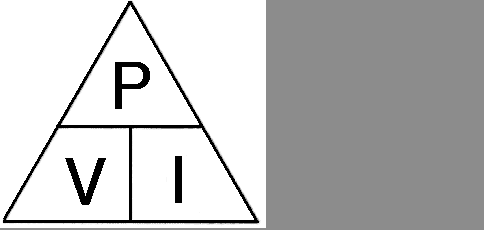



| |
2B1 Q7 Recall that power is measured in Watts (W).
For the moment you need to know the Power is
measured in Watts we come to how that is determined in a little
while.
Recall that a current through a resistor results in conversion of electrical energy to heat energy in the resistor.
We
digress from the syllabus as you need to know what a resistor is to
understand the next part. Imagine you are pushing against a wall but the
wall does not move but it does offer what you would feel as a resistance
to your pushing. So with that in mind a resistor acts like the wall to a
flow of electrons, a current flow.
When
an electric current passes through a resistor its resistance results in
the conversion of the electrical energy, the flowing current, to heat
energy and this makes the resistor warm up and if there is too much
current flowing the resistor can be destroyed.
Understand that Power (Watts) in a circuit is the product of the Potential Difference (Voltage) and the Current (Amps) ie P=V×I
We
saw in an earlier part of the course that the unit of measurement of
electrical potential is the Volt (V) and the unit of measurement of electric
current flowing in a circuit is the Ampere (I) (more commonly called the
Amp).
Both the volts and the amps exist in the circuit the potential difference of volts push the current the amps round the circuit and there is a relationship between the amount of volts and the amount of amps and this is calculated by the equation :-
P = V × I where
P = power in Watts, V = the amount of volts, and I = the amount of current.
Calculate the unknown quantity given the
numerical value of the other two.
Up until now all you have had to do in the course is understand word and if you had never heard of them before commit them to memory. Well now the course takes a different path and for some of you this will not be a happy moment as it means going back to do some mathematics which you may not have done since you were in school of if you are still in school never realised where you would use mathematics out side of school lessons and examination.
As mentioned earlier fortunately for us those clever persons years ago found out that there was a simple relationship between Voltage, Current and Power this formula is :-
P = V x I
Power = Voltage x Current
and the relationships to find the third one knowing the other two are more easily shown in what is called a magic triangle.

Just as with the other magic triangle we now have Power at the top and volts and current on the bottom. So if you wish to know the power cover that one and it leaves volts and current exposed and on the same line so they are multiplied together. Wanting to know volts leaves power above current so divide power by current and similarly wanting to know current leaves power above volt so divide power by volts.
If there is a lamp in a circuit and the volts measure 6 volts and the current measures 0.5amps what power is being dissipated ?
P = V x I
P = 6 x 0.5 = 3 watts
If there is a resistor in a circuit and power is 4 watts and the input voltage is 2 volts what current is flowing ?
P = V x I thus I = P  V thus I = 4
V thus I = 4  2 = 2 amps
2 = 2 amps
The origin of some of the text on this page is from the RSGB with additions by the web master